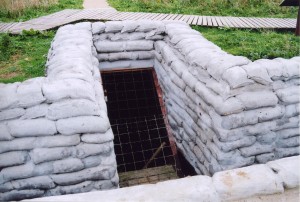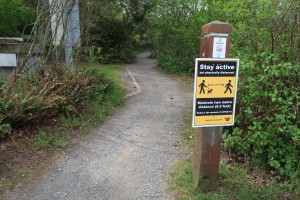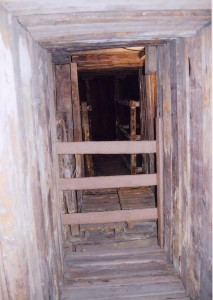Selected from the Rescuers

Dugout entrance at the excavated and preserved Yorkshire Trench site near Boezinge, Belgium. Entrances are often flooded and are covered with wire.
(P. Ferguson image, September 2004)
Camouflet
- a mine so charged and placed that its detonation will destroy enemy mining tunnels.
- 2a. an underground or subsurface explosion of a bomb or shell that leaves a sealed pocket of smoke and gas. 2b. a pocket formed in this way.
(Merriam-Webster Dictionary)
I return this evening to a favoured online resource. As I move through the digitized images one by one, I am careful not to let the similar looking pages drift one into another. At times I catch myself veering slightly off-course…steady…steady…refocus…letting go of any thoughts that perhaps there is a better way. Each group of records numbers somewhere between 1,750 – 1,850 names and takes two hours to view. It is a wonderful resource, but as researchers know, not all the pages are relevant. This night I start where I left off from a previous evening…Name Range: Bradley, A.E. – Brown, J. page 750. It is the 8th section I have worked through..there are several others to follow.
The work is a welcome diversion from the daily news I watch and I choose this night to remain indoors rather than seek the fresh air of an early evening. Our encounters with any other persons, these days, are so importantly reduced by physical distancing with a polite wave or hello from afar. I appreciate this bobbing and weaving especially when there is breadth of road along the path, and at all times I avoid the popular thoroughfares and places that attract the most people. Watching ahead and looking behind…Where are they headed…They have committed left I go right…wave and carry on.

Stay active but physically distanced.
A COVID-19 signed narrow path…a bit narrow for me these days.
I will find another way.
(P. Ferguson image, April 2020)
Returning to my Great War online resource I am pleased that shortly into my search I find one name, Briscoe – page 863, that includes, within its record of life-saving, the names of three other soldiers caught in the same onslaught. It is unusual that all four men share the same words of a citation. So too the circumstances of the event are somewhat unusual compared to the many others I have read.
From the time of discovery to placing these words online can take an additional two or more hours. What is the story…or for that matter, a better question – where is the story beyond the obvious? How do I want to present it? Is this a Dragnet night, just the facts please, or one for all musing? What lurks within my memory – can I access its place for here? Does it fit? Then there are the images…much is dependent on images…what do I have…where is it…what else can I use?
Though I tend to write as I speak, I do prefer to read my words at a considered pace. I effect a cadence rather than a “speed read” in search of the end. One gains more in the considered rather than in the fleeting. Tempo defines character. Probably Adagio before Allegro…breathing – the space (not the kerning) between words…Foote and McCullough…so many ways to say the same line…which cadence do we keep? Which line do we use and so it goes until the publish button is pushed.
Once again, the 7PM clamor has started. A reminder to self to recognize the deeds of others and, for the preservation of self, to enjoy this day we’ve been given…no matter what it brings…we at least have this day. Stay safe everyone.

A dugout at Dixmude, Belgium.
Bunks can be seen just beyond the three horizontal strips of wood.
(P. Ferguson image, September 2004)
Corporal Richard Rainford
Sergeant Thomas Clifford Briscoe
Private Harold Leslie Edwards
Private Albert Ernest Carey
38th Canadian Infantry Battalion
Each soldier awarded the Military Medal
For conspicuous gallantry on early morning of 26th March 1917 near SOUCHEZ.
The enemy blew a camouflet at 5:20 a.m. and broke into one of our Mining Shafts. The force of the explosion burst in the sides of a dug-out near one of the Mine galleries. Twenty men were in the dug-out when the explosion occurred. Three of these managed to make their way out but the remainder were unable to gain the surface.
About a dozen men were standing in the trench near the dug-out entrance, amongst whom were CPL. RAINFORD, SGT. BRISCOE, PTES. EDWARDS and CAREY. These men, without consideration of their own safety, and also having seen the gas flame rush from the mouth of the dug-out, singeing the hair and burning the faces of some, entered the dug-out and succeeded in bringing 10 men to the surface. The remaining seven men were found to be killed. These men assisted in the work of resuscitation of those overcome by gas.
The men rescued were badly burned and gassed and must have been overcome by fumes but for the prompt and gallant action of these men. Some of the rescuers themselves were badly affected by the gas.
These four men have been selected from the rescuers as being those who rendered the best services.
Their prompt and gallant action undoubtedly saved the loss of 10 of their comrades and it is considered that they are fully deserving of an Immediate Award.
Soldiers of the 38th Battalion
Killed in the Camouflet Incident
Souchez, France
Buried at Villers Station Cemetery, Villers-au-Bois, France
VII F 21 – VII F 27
…They are together…
410670 Private Ernest David Ruffles
775656 Private George Nicholls
261714 Private Gus Sheff
261714 Private William Valentine
775645 Private Charles Gordon Matthewson
775323 Private George William Ewart Jemmett
669154 Private George Frederick Giddins

Comments